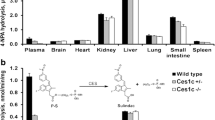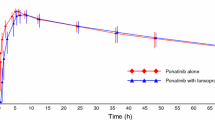Abstract
Background
Proton pump inhibitors (PPIs) are pro-drugs requiring an acidic pH for activation. The specificity of PPI toward the proton pump is mainly due to the extremely low pH at the parietal cell canalicular membrane where the pump is located. Reactivity of PPIs was also observed in moderately acidic environments like the renal collecting duct. But no PPI effect on lysosomal enzymes has been observed possibly because the previous studies were performed with liver tissue, where PPIs are metabolized.
Methods
The reactivity of PPIs (omeprazole, lansoprazole and pantoprazole) with a cysteine-containing peptide was analyzed by mass spectrometry, and the impact of PPIs on lysosomal enzymes was evaluated in cultured cells and mice. The effect of PPIs on the immune system was examined with a mouse tumor immunotherapy model.
Results
Incubation of a cysteine-containing peptide with PPIs at pH5 led to the conversion of most of the peptide into PPI-peptide adducts. Dose dependent inhibition of lysosomal enzyme activities by PPIs was observed in cultured cells and mouse spleen. Further, PPI counteracted the tumor immunotherapy in a mouse model.
Conclusions
Our data support the hypothesis that many of the PPI adverse effects are caused by systematically compromised immunity, a result of PPI inhibition of the lysosomal enzymes. This novel mechanism complements the existing mechanisms in explaining the increased incidence of tumorigenesis and infectious diseases among PPI users and underlie the ongoing concern about the overuse of PPIs in adult and pediatric populations.





Similar content being viewed by others
Abbreviations
- AP:
-
Acid phosphatase
- CID:
-
Collision-induced dissociation
- GERD:
-
Gastroesophageal reflux disease
- MPO:
-
Myeloperoxidase
- NAG:
-
β-N-acetylglucosaminidase
- PPIs:
-
Proton pump inhibitors
References
Bamberg P, Caswell CM, Frame MH, Lam SK, Wong EC. A meta-analysis comparing the efficacy of omeprazole with H2-receptor antagonists for acute treatment of duodenal ulcer in Asian patients. J Gastroenterol Hepatol. 1992;7:577–85.
Eriksson S, Langstrom G, Rikner L, Carlsson R, Naesdal J. Omeprazole and H2-receptor antagonists in the acute treatment of duodenal ulcer, gastric ulcer and reflux oesophagitis: a meta-analysis. Eur J Gastroenterol Hepatol. 1995;7:467–75.
Gisbert JP, Gonzalez L, Calvet X, Roque M, Gabriel R, et al. Proton pump inhibitors versus H2-antagonists: a meta-analysis of their efficacy in treating bleeding peptic ulcer. Aliment Pharmacol Ther. 2001;15:917–26.
Gisbert JP, Khorrami S, Calvet X, Gabriel R, Carballo F, et al. Meta-analysis: proton pump inhibitors vs. H2-receptor antagonists—their efficacy with antibiotics in Helicobacter pylori eradication. Aliment Pharmacol Ther. 2003;18:757–66.
Welage LS. Overview of pharmacologic agents for acid suppression in critically ill patients. Am J Health Syst Pharm. 2005;62:S4–10.
Zed PJ, Loewen PS, Slavik RS, Marra CA. Meta-analysis of proton pump inhibitors in treatment of bleeding peptic ulcers. Ann Pharmacother. 2001;35:1528–34.
Leontiadis GI, Sharma VK, Howden CW. Proton pump inhibitor therapy for peptic ulcer bleeding: cochrane collaboration meta-analysis of randomized controlled trials. Mayo Clin Proc. 2007;82:286–96.
Brandstrom A, Lindberg P, Bergman N-A, Alminger T, Ankner K, et al. Chemical reactions of omeprazole and omeprazole analogues. I. A survey of the chemical transformations of omeprazole and its analogues. Acta Chem Scand. 1989;B43:536–48.
Mattsson JP, Vaananen K, Wallmark B, Lorentzon P. Omeprazole and bafilomycin, two proton pump inhibitors: differentiation of their effects on gastric, kidney and bone H(+)-translocating ATPases. Biochim Biophys Acta. 1991;1065:261–8.
Mizunashi K, Furukawa Y, Katano K, Abe K. Effect of omeprazole, an inhibitor of H+, K(+)-ATPase, on bone resorption in humans. Calcif Tissue Int. 1993;53:21–5.
Vestergaard P, Rejnmark L, Mosekilde L. Proton pump inhibitors, histamine H2 receptor antagonists, and other antacid medications and the risk of fracture. Calcif Tissue Int. 2006;79:76–83.
Burdan F, Siezieniewska Z, Maciejewski R, Madej B, Radzikowska E, et al. Hepatic lysosomal enzymes activity and liver morphology after short-time omeprazole administration. Exp Toxicol Pathol. 2002;53:453–9.
Fujisaki H, Oketani K, Nagakawa J, Takenaka O, Yamanishi Y. Effects of rabeprazole, a gastric proton pump inhibitor, on biliary and hepatic lysosomal enzymes in rats. Jpn J Pharmacol. 1998;76:279–88.
Grinpukel S, Sewell R, Yeomans N, Mihaly G, Smallwood R. Lack of effect of omeprazole, a potent inhibitor of gastric (H+ + K+) ATPase, on hepatic lysosomal integrity and enzyme activity. J Pharm Pharmacol. 1986;38:158–60.
Trinidad JC, Thalhammer A, Specht CG, Lynn AJ, Baker PR, et al. Quantitative analysis of synaptic phosphorylation and protein expression. Mol Cell Proteomics. 2008;7:684–96.
Kilinc MO, Aulakh KS, Nair RE, Jones SA, Alard P, et al. Reversing tumor immune suppression with intratumoral IL-12: activation of tumor-associated T effector/memory cells, induction of T suppressor apoptosis, and infiltration of CD8+ T effectors. J Immunol. 2006;177:6962–73.
Hill HC, Conway TF Jr, Sabel MS, Jong YS, Mathiowitz E, et al. Cancer immunotherapy with interleukin 12 and granulocyte-macrophage colony-stimulating factor-encapsulated microspheres: coinduction of innate and adaptive antitumor immunity and cure of disseminated disease. Cancer Res. 2002;62:7254–63.
Terpstra AH. Differences between humans and mice in efficacy of the body fat lowering effect of conjugated linoleic acid: role of metabolic rate. J Nutr. 2001;131:2067–8.
Jalving M, Koornstra JJ, Wesseling J, Boezen HM, De Jong S, et al. Increased risk of fundic gland polyps during long-term proton pump inhibitor therapy. Aliment Pharmacol Ther. 2006;24:1341–8.
Choudhry U, Boyce HW Jr, Coppola D. Proton pump inhibitor-associated gastric polyps: a retrospective analysis of their frequency, and endoscopic, histologic, and ultrastructural characteristics. Am J Clin Pathol. 1998;110:615–21.
Cats A, Schenk BE, Bloemena E, Roosedaal R, Lindeman J, et al. Parietal cell protrusions and fundic gland cysts during omeprazole maintenance treatment. Hum Pathol. 2000;31:684–90.
Ekman L, Hansson E, Havu N, Carlsson E, Lundberg C. Toxicological studies on omeprazole. Scand J Gastroenterol Suppl. 1985;108:53–69.
Haga Y, Nakatsura T, Shibata Y, Sameshima H, Nakamura Y, et al. Human gastric carcinoid detected during long-term antiulcer therapy of H2 receptor antagonist and proton pump inhibitor. Dig Dis Sci. 1998;43:253–7.
Dawson R, Manson JM. Omeprazole in oesophageal reflux disease. Lancet. 2000;356:1770–1.
Hodgson N, Koniaris LG, Livingstone AS, Franceschi D. Gastric carcinoids: a temporal increase with proton pump introduction. Surg Endosc. 2005;19:1610–2.
Waldum HL, Gustafsson B, Fossmark R, Qvigstad G. Antiulcer drugs and gastric cancer. Dig Dis Sci. 2005;50(Suppl 1):S39–44.
Jianu CS, Lange OJ, Viset T, Qvigstad G, Martinsen TC, et al. Gastric neuroendocrine carcinoma after long-term use of proton pump inhibitor. Scand J Gastroenterol. 2012;47:64–7.
Poulsen AH, Christensen S, McLaughlin JK, Thomsen RW, Sorensen HT, et al. Proton pump inhibitors and risk of gastric cancer: a population-based cohort study. Br J Cancer. 2009;100:1503–7.
Hagiwara T, Mukaisho K, Nakayama T, Sugihara H, Hattori T. Long-term proton pump inhibitor administration worsens atrophic corpus gastritis and promotes adenocarcinoma development in Mongolian gerbils infected with Helicobacter pylori. Gut. 2011;60:624–30.
Carter DC. Cancer after peptic ulcer surgery. Gut. 1987;28:921–3.
Caygill CP, Hill MJ, Kirkham JS, Northfield TC. Mortality from gastric cancer following gastric surgery for peptic ulcer. Lancet. 1986;1:929–31.
Freston JW. Clinical significance of hypergastrinaemia: relevance to gastrin monitoring during omeprazole therapy. Digestion. 1992;51(Suppl 1):102–14.
Garcia Rodriguez LA, Ruigomez A. Gastric acid, acid-suppressing drugs, and bacterial gastroenteritis: how much of a risk? Epidemiology. 1997;8:571–4.
Doorduyn Y, Van Pelt W, Siezen CL, Van Der Horst F, Van Duynhoven YT, et al. Novel insight in the association between salmonellosis or campylobacteriosis and chronic illness, and the role of host genetics in susceptibility to these diseases. Epidemiol Infect. 2008;136:1225–34.
Neal KR, Briji SO, Slack RC, Hawkey CJ, Logan RF. Recent treatment with H2 antagonists and antibiotics and gastric surgery as risk factors for Salmonella infection. BMJ. 1994;308:176.
Garcia Rodriguez LA, Ruigomez A, Panes J. Use of acid-suppressing drugs and the risk of bacterial gastroenteritis. Clin Gastroenterol Hepatol. 2007;5:1418–23.
Doorduyn Y, Van Den Brandhof WE, Van Duynhoven YT, Wannet WJ, Van Pelt W. Risk factors for Salmonella Enteritidis and Typhimurium (DT104 and non-DT104) infections in The Netherlands: predominant roles for raw eggs in Enteritidis and sandboxes in Typhimurium infections. Epidemiol Infect. 2006;134:617–26.
Neal KR, Scott HM, Slack RC, Logan RF. Omeprazole as a risk factor for campylobacter gastroenteritis: case–control study. BMJ. 1996;312:414–5.
Leonard J, Marshall JK, Moayyedi P. Systematic review of the risk of enteric infection in patients taking acid suppression. Am J Gastroenterol. 2007;102:2047–56; quiz 2057.
Dial MS. Proton pump inhibitor use and enteric infections. Am J Gastroenterol. 2009;104(Suppl 2):S10–6.
Howell MD, Novack V, Grgurich P, Soulliard D, Novack L, et al. Iatrogenic gastric acid suppression and the risk of nosocomial Clostridium difficile infection. Arch Intern Med. 2010;170:784–90.
Linsky A, Gupta K, Lawler EV, Fonda JR, Hermos JA. Proton pump inhibitors and risk for recurrent Clostridium difficile infection. Arch Intern Med. 2010;170:772–8.
Sheen E, Triadafilopoulos G. Adverse effects of long-term proton pump inhibitor therapy. Dig Dis Sci. 2011;56:931–50.
Andersson T. Pharmacokinetics, metabolism and interactions of acid pump inhibitors. Focus on omeprazole, lansoprazole and pantoprazole. Clin Pharmacokinet. 1996;31:9–28.
Andersson T, Olsson R, Regardh CG, Skanberg I. Pharmacokinetics of [14C]omeprazole in patients with liver cirrhosis. Clin Pharmacokinet. 1993;24:71–8.
Slattery E, Theyventhiran R, Cullen G, Kennedy F, Ridge C, et al. Intravenous proton pump inhibitor use in hospital practice. Eur J Gastroenterol Hepatol. 2007;19:461–4.
Forgacs I, Loganayagam A. Overprescribing proton pump inhibitors. BMJ. 2008;336:2–3.
Choudhry MN, Soran H, Ziglam HM. Overuse and inappropriate prescribing of proton pump inhibitors in patients with Clostridium difficile-associated disease. QJM. 2008;101:445–8.
van Boxel OS, Hagenaars MP, Smout AJ, Siersema PD. Socio-demographic factors influence chronic proton pump inhibitor use by a large population in the Netherlands. Aliment Pharmacol Ther. 2009;29:571–9.
Gawron AJ, Rothe J, Fought AJ, Fareeduddin A, Toto E, et al. Many patients continue using proton pump inhibitors after negative results from tests for reflux disease. Clin Gastroenterol Hepatol. 2012;10:620–5.
Moore DJ, Tao BS, Lines DR, Hirte C, Heddle ML, et al. Double-blind placebo-controlled trial of omeprazole in irritable infants with gastroesophageal reflux. J Pediatr. 2003;143:219–23.
Orenstein SR, Hassall E, Furmaga-Jablonska W, Atkinson S, Raanan M. Multicenter, double-blind, randomized, placebo-controlled trial assessing the efficacy and safety of proton pump inhibitor lansoprazole in infants with symptoms of gastroesophageal reflux disease. J Pediatr. 2009;154(514–520):e514.
Hassall E. Over-prescription of acid-suppressing medications in infants: how it came about, why it’s wrong, and what to do about it. J Pediatr. 2012;160:193–8.
Acknowledgments
This work was supported by a departmental start-up fund (to L.Z.). Mass spectrometry analysis was provided by the UCSF Mass Spectrometry Facility (A.L. Burlingame, Director) supported by the Biomedical Research Technology Program of the National Center for Research Resources, NIH NCRR RR001614 and NIH NCRR RR019934.
Conflict of interest
The authors declare that they have no conflict of interest.
Author information
Authors and Affiliations
Corresponding author
Rights and permissions
About this article
Cite this article
Liu, W., Baker, S.S., Trinidad, J. et al. Inhibition of lysosomal enzyme activities by proton pump inhibitors. J Gastroenterol 48, 1343–1352 (2013). https://doi.org/10.1007/s00535-013-0774-5
Received:
Accepted:
Published:
Issue Date:
DOI: https://doi.org/10.1007/s00535-013-0774-5




